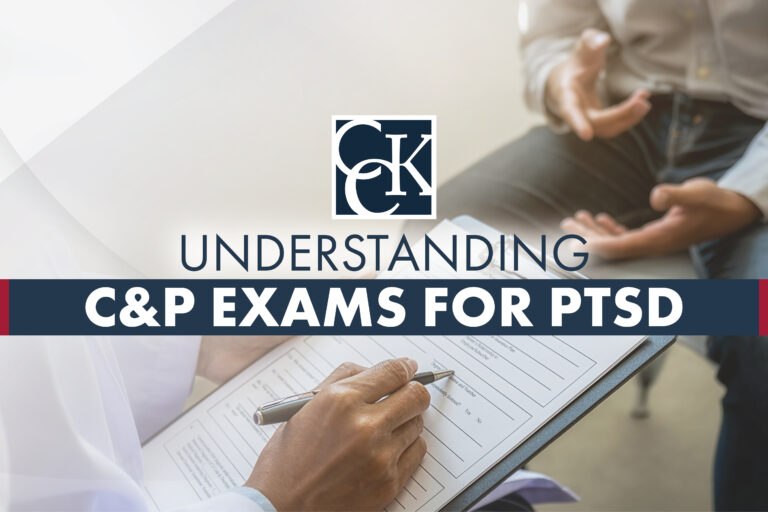Understanding C&P Exams for PTSD

CCK Law: Our Vital Role in Veterans Law
Post-traumatic stress disorder (PTSD) is a mental health condition that may occur as a result of a person experiencing a distressing, shocking, or otherwise traumatic event.
Symptoms of PTSD may include nightmares, flashbacks, difficulty concentrating, and extreme anxiety, as well as uncontrollable thoughts about the event. PTSD is one of the most common service-connected disabilities, with almost 1.5 million veterans receiving compensation for PTSD in 2023.
After a veteran files a claim for PTSD, VA may order a Compensation and Pension (C&P) examination so a medical professional can deliver an opinion about whether the PTSD is connected to the veteran’s military service. This article will discuss some CCK insights into what veterans need to know about VA C&P exams for PTSD.

Before the Exam
When Does VA Request a C&P Exam for PTSD?
C&P exams are medical exams ordered by VA to evaluate veterans’ disability claims. Not everyone is required to attend a VA exam. After a veteran files their initial claim for PTSD, they may receive a phone call or a letter from VA or a VA contract examiner to schedule a PTSD C&P exam.
VA usually does not schedule C&P exams for PTSD unless there is some indication of two or three of the criteria needed for service connection. These criteria include having a current diagnosis, having an in-service stressor, and having a medical nexus between the post-traumatic stress disorder and the in-service stressor.
For example, VA might schedule a C&P exam if a veteran’s records show that there was a traumatic event in service and also some medical evidence suggesting PTSD symptoms.
Therefore, it is highly recommended that veterans prepare their PTSD claims thoroughly before filing. Here are some resources:
- How to File a VA Claim for PTSD
- How to Use Lay Evidence for VA Disability Claims
- Top Tips for C&P Exams
Who Will Administer a VA C&P Exam for PTSD?
VA-approved psychologists, psychiatrists, or other mental health professionals conduct C&P exams for PTSD. VA will select and assign the examiner. The examiner may be a VA employee or an independent contractor.
The examiner will have access to a veteran’s full claims file (c-file) prior to the C&P exam. Ideally, they will review this file before meeting with the veteran, as well as medical records, lay statements, and treatment notes that may be relevant to the veteran’s disability claim.
However, the veteran should be prepared to draw attention to key information if the examiner is not prepared.
Examination Day
There are several general tips that veterans should consider for their PTSD C&P examination.
- Be honest: Veterans should be accurate during their examination for PTSD. It is vital that they do not under- or over-report their symptomology.
- Bring somebody: Those veterans who must attend a C&P exam may bring somebody with them. This second person can offer additional information, help the veteran feel more comfortable, or serve as a witness if the examiner does not conduct an adequate examination.
- Bring notes about PTSD symptoms: Notes like a symptom log can ensure that the veteran is complete and accurate in their descriptions.
- Be aware: VA examiners are likely to observe the veteran from the moment they walk into the waiting room. So, it is important that veterans be aware of their surroundings and their interactions with other patients and staff.
- Don’t be afraid to correct the examiner. If a veteran hears the examiner suggest information or rephrase an answer incorrectly, the veteran should not hesitate to politely correct them.
- Research the rating criteria. If VA finds that the veteran’s PTSD is service-connected, VA will assign a disability rating from 0 to 100 percent. It can be helpful to understand what criteria will be used to assign the rating.
PTSD Checklist for DSM-5 (PCL-5)
In some cases, veterans are given the PTSD Checklist for DSM-5 (PCL-5) to complete while sitting in the waiting room before their appointments. This is meant to be an initial assessment of both the presence and severity of the veteran’s PTSD symptoms.
This checklist is a short 20-question checklist where veterans are asked to go through and report specific things that they experienced over a certain period. Then the examiner will use this to gauge the veteran’s initial symptoms prior to the exam.
Note regarding GAF scores: Before switching to the DSM-5, VA used Global Assessment of Functioning (GAF) scores to evaluate the severity of PTSD. Today, GAF scores are no longer used, as they were found to be less reliable in determining the severity of symptomology. However, if the veteran’s case for PTSD was certified to the Board prior to August 4, 2014, then the veteran is allowed to use their GAF scores as evidence.
VA DBQ for PTSD
During a C&P exam for PTSD, the medical examiner will likely complete a Disability Benefits Questionnaire (DBQ). A DBQ uses check boxes and standardized language so that the disability evaluation can be made quickly and correctly.
A C&P examiner for a PTSD exam will use criteria from the Diagnostic and Statistical Manual of Mental Disorders, Fifth Edition (DSM-V) to reach a diagnosis of PTSD. This diagnostic criteria section of the DBQ is broken down into six categories (Criteria A-F). The subsequent section lists additional symptoms related to PTSD.
Assuming a veteran meets all the criteria from the DSM-V necessary for a PTSD diagnosis, the symptoms section of the DBQ will then help determine an appropriate disability evaluation.
Another important section of the DBQ addresses the veteran’s level of occupational and social impairment. Here, the level of impairment due to PTSD ranges from no diagnosis to total occupational and social impairment, with various levels in between.
Clinician-Administered PTSD Scale for DSM-5 (CAPS-5)
The Clinician-Administered PTSD Scale for DSM-5 (CAPS-5) may also be administered during the C&P exam.
It is usually provided in a structured 30-minute interview during which the examiner asks questions that are intended to gauge what the veteran’s PTSD symptoms are, the duration and onset of those symptoms, how they affect the veteran in terms of occupational and social impairment (e.g., work, family, relationships, etc.).
After the Exam
VA Disability Ratings for PTSD
After the C&P exam is complete, VA adjudicators will review it along with all the other evidence in the veteran’s claims file.
If the VA finds service connection, then VA will rate PTSD using 38 CFR § 4.130, Diagnostic Code 9411. The disability rating will be 0, 10, 30, 50, 70, or 100 percent, based on the level of social and occupational impairment, as well as the frequency, duration, and severity of symptoms.

What If the Examiner Finds a Different Condition Than PTSD?
If the examiner happens to diagnose the veteran with a mental health condition that is not PTSD, but is related to their service, VA can still award service connection.
When adjudicating the claim, VA is supposed to take any mental health diagnosis that is linked to service and grant service connection regardless of what the veteran filed the disability claim for.
Read more about how VA rates mental health disorders.
Challenging Unfavorable PTSD C&P Exam Results
Veterans may disagree with the results of their PTSD C&P exam. Whether you receive an outright denial or an unfavorable rating, it is important to remember that VA frequently makes mistakes and that there are multiple ways to combat an unfavorable C&P exam result.
Recognize Mistakes That VA Can Make on PTSD C&P Exams
- Claiming the veteran is “malingering.” This means that the VA examiner believes the veteran is exaggerating some of their symptoms or is over-reporting certain aspects of their condition.
- Insufficient analysis or explanation. Examiners must provide a detailed explanation for their conclusions. If the VA examiner only checks a few boxes and does not provide an explanation, then the exam is not adequate for PTSD disability rating purposes.
Gather Evidence to Challenge VA PTSD C&P Examination Results
Veterans can counter C&P exam results with additional evidence like independent medical exams and lay evidence like buddy statements.
If a veteran has additional evidence in support of their PTSD claim, then it may be beneficial to submit it to VA before or following their C&P exam, especially if they decide to challenge the exam results.
Veterans are entitled to go to outside doctors (i.e., private physicians) to obtain opinions that will be weighed against VA examinations. Private treatment notes and medical records may provide more favorable evidence.
VA cannot treat the VA examination as more probative (i.e., give it more weight) than private medical opinions. Instead, VA must consider what both of the opinions contain and what evidence the examiners considered to reach it.
Likewise, VA must provide adequate rationale for deciding that one of these medical opinions has more probative value. If VA does not do so, then the veteran can rebut VA’s determinations.
Hire an Accredited Advocate Like CCK to Challenge Unfavorable PTSD C&P Exam Results
If you have received an unfavorable result from VA after a PTSD C&P exam, then CCK may be able to help.
Since 1999, our accredited attorneys and advocates have been developing the processes, tools, and relationships necessary to maximize benefits while making appeals as efficient as possible. We fight VA so veterans can focus on their health and responsibilities while getting the benefits that they need and deserve.
Call us today at (800) 544-9144 for a free case evaluation with a member of our team to see if we can assist.
About the Author
Share this Post
